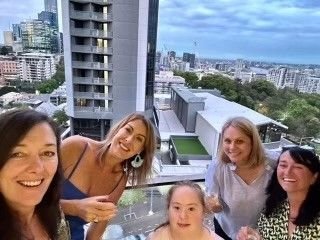Inclusive job practices leave no one behind
four women smiling, in a semi circle around a young woman with Down Syndrome taking a selfie. They are on a balcony with the Brisbane skyline behind, young woman with down in the centre of the photo is a taking a selfie our women
Last night, I had the opportunity to read The Guardian article titled "Mar Galcerán makes history as Spain’s first parliamentarian with Down’s syndrome" and explore the hyperlinks.
The article emphasised the theme of individual effort, showcasing individuals like Mar Galcerán, Ángela Bachille (Spain’s first city councillor with Down syndrome in 2013), Éléonore Laloux (the first person with Down syndrome elected into local government in 2020), and Fintan Bray (elected in Ireland in 2020 as the country’s first city councillor with Down’s syndrome) as role models for people with Down Syndrome with political aspirations.
However, individual effort alone is insufficient to eliminate barriers for individuals with intellectual impairments, particularly those with Down syndrome, in gaining meaningful work.
In Australia, the unemployment rate for people with an intellectual impairment is 18%, significantly higher than the 4% unemployment rate for those without disabilities. Additionally, for individuals with Down syndrome over the age of 25, a staggering 65% are unemployed, with only 7% of those people employed working in in open employment (Down Syndrome Australia)
A collective approach is necessary to expand employment opportunities and recognise the value of contributions from people with diverse backgrounds and experiences.
While reading these articles, I found myself curious about the specific inclusive job practices that enabled these trailblazers to perform at their best.
Inclusive job practices encompass various elements, such as accessible systems and environments, workplace adjustments, inclusive policies, flexible workplace arrangements, and inclusive job design.
I wanted to know whether information was presented in an Easy Read format, how wayfinding was facilitated, whether work portfolios were redesigned to align with strengths and interests, if there were modifications to work hours, changes in how work was executed, development of disability confidence capability in work colleagues, and the availability of support workers or assistants if needed.
Closing the unemployment gap requires an awareness and understanding of inclusive work practices. We need to include inclusive job design, accessibility modifications, flexible workplace practices in the diversity and inclusion conversations if we are committed to #leavenoonebehind.
I hope future articles include inclusive job design practices that make it easier for people to work at their best and create a more inclusive working world.
#diversityandinclusion #inclusionmatters #inclusivejobdesign #occupationaltherapists
